Joe Hinrichs has got a wish list. He wants to see robots on the shopfloor that will revolutionise productivity and offer new levels of skilled automation and safety. AMS talks to him about the future of Ford manufacturing
There can be no doubt that robots are an integral and vital cog in the automotive manufacturing industry, but it was not always the case. Just 25 years ago only about 6,000 robots were at work in factories in the US. Since 1982 that number has exploded to more than 170,000 according to the Robotic Industries Association (RIA). More than one million industrial robots are at work around the world. The advent of the robot on the assembly line has fundamentally transformed manufacturing.
One man at the heart of Ford’s manufacturing strategy, and the part that robots play in that approach, is Joe Hinrichs, Group Vice President of Global Manufacturing. He is responsible for the operations of 105 assembly, stamping and powertrain plants worldwide. Additionally, Hinrichs oversees the company’s worldwide engineering support for the stamping function, as well as vehicle and powertrain manufacturing.
 He has global responsibility for the company’s Material Planning & Logistics, Ford production system and manufacturing business office organisations, a role he assumed at the start of 2007. It was at the tail end of 2007 that I caught up with Hinrichs, in Orlando, Florida where he was giving the keynote speech to the RIA’s annual conference. “At Ford we are changing the way work is done,” Hinrichs explains. “You’re probably aware that Ford just reached a tentative agreement with the United Auto Workers (UAW) on a new contract. And, while I can’t go into specifics about that contract with you, I can tell you that we are changing the way work is done. I believe it’s a positive change that will make us a better company in the long run.”
He has global responsibility for the company’s Material Planning & Logistics, Ford production system and manufacturing business office organisations, a role he assumed at the start of 2007. It was at the tail end of 2007 that I caught up with Hinrichs, in Orlando, Florida where he was giving the keynote speech to the RIA’s annual conference. “At Ford we are changing the way work is done,” Hinrichs explains. “You’re probably aware that Ford just reached a tentative agreement with the United Auto Workers (UAW) on a new contract. And, while I can’t go into specifics about that contract with you, I can tell you that we are changing the way work is done. I believe it’s a positive change that will make us a better company in the long run.”
Forefront of efficiency
Ford has, since its earliest days, been a company on the vanguard of change. Henry Ford, after all, was the man who moved automotive production from station assembly to a rudimentary assembly line with teams of men using ropes to pull car chassis through the shop as other teams bolted on the body and components. It was not a big step from there to the moving assembly line, although in terms of production efficiency that evolution is akin to the difference between talking through tin cans connected by string and using a cell phone. Ford was at the forefront of manufacturing engineering, working to improve assembly line efficiency. At the apex of Model T production, the Highland Park plant assembled a Tin Lizzie from start to finish in just 93 minutes. “By the time the first Model As were built in 1928, we had learned a lot about volume production – lessons that were both good and bad,” Hinrichs continued. “We pushed the limits of what staff and machines could do on a 10-hour shift and by the time the 1950s came around, we had improved the ergonomics on the line but still did most everything by hand.
“In more recent years, we’ve dusted off some pages from Henry Ford’s manufacturing philosophy and brought our plants into the modern era through lean manufacturing. We’ve improved work and material flow and eliminated waste. We’ve become flexible by improving our work cell design and our plant layouts. This allows us to maximise our efficiency and adjust our product mix to fit the market.”
Competitive operating 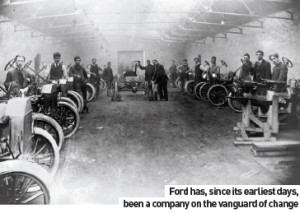
In recent months, Ford has reached new agreements with its hourly workforce in the way work is structured, allocated and performed in its plants. Dubbed ‘competitive operating agreements’, these new work rules are the foundation of the very productive national contract negotiations that Ford has just wrapped up. “Transforming manufacturing is nothing new for us, it’s been a way of life for over a hundred years. And robots are an important part of the transformation that is taking place at Ford today.”
Automotive manufacturers, particularly OEMs, continue to be the lifeblood for robot manufacturers, with something in the region of 70 per cent of robot sales being made to auto manufacturers. Given that reliance on a single sector, robot manufacturers are all too aware of the challenges faced by the automotive business over the past three or four years. “Long story short, Ford’s share of the US market is smaller than it used to be,” Hinrichs says. “We are now at 15.7 per cent. Our capacity is greater than the demand for our products and that spells inefficiency and increased cost. In January 2006, we announced our turnaround plan including, among other things, the closure of 16 of our plants in North America by 2012.”
Priorities for recovery
Ford’s recovery plan has been well documented, but in brief it has four main components. These are to aggressively restructure the company across the board to be profitable at a lower volume and with a changed product mix. Then they plan to accelerate product development while reducing complexity and improving product quality. Thirdly, Ford intends to work together to improve teamwork and accountability and, finally, it is intent on securing financing to complete the plans. “Focusing on these key priorities is transforming our business model and represents a very real opportunity for us. We’re focusing on our core business – building and selling cars and trucks – and we’re making our capital allocations accordingly. We’re investing in engines, transmissions and stamping.
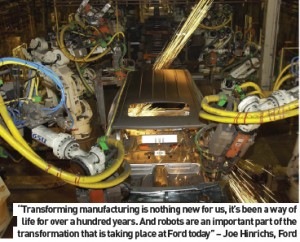 “We’re doing this because we know that we need to control very closely those aspects of production that are integral to the technology and design quality of the vehicle. We can do that best – and most efficiently – from the inside.” What is the result of this focus on the company’s core business? First, Ford is resizing its capacity to more closely match current and projected market demand. That means the closing of plants, the consolidation of product builds and a reduction in its workforce through attrition and buyouts.
“We’re doing this because we know that we need to control very closely those aspects of production that are integral to the technology and design quality of the vehicle. We can do that best – and most efficiently – from the inside.” What is the result of this focus on the company’s core business? First, Ford is resizing its capacity to more closely match current and projected market demand. That means the closing of plants, the consolidation of product builds and a reduction in its workforce through attrition and buyouts.
“We’ve been very effective in carrying out our plans so far,” Hinrichs says. “We’ve closed eight of our plants and have reduced our hourly workforce by over 30,000 employees. We’ve increased our emphasis on flexibility and efficiency in a smaller manufacturing footprint. We’re zeroing in on quality improvements through improved processes in all our plants.”
The role of robots
As you can imagine, robots have an important role to play in the restructuring of Ford’s operations and the reconfiguration of the work carried out inside its plants. Today, Ford has about 11,000 robots involved in North American manufacturing, purchasing about 600 additional robots per year. Even though the company is closing plants, it is reallocating robots to plants where production is being consolidated. In those plants they have been able to add robots, assembly lines have been redesigned and cell layouts reconfigured to gain increased flexibility.
A perfect example of this can be seen at the Oakville assembly plant near Toronto, where Hinrichs had first-hand 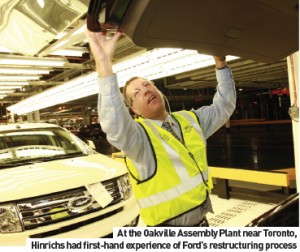 experience of the process. “I’m intimately familiar with what went on there because I was in charge of our vehicle operations at the time,” he says. “With the discontinuation of our minivan business and the launch of our new crossover vehicles, we were able to take some robots from idled plants and add them to Oakville for the flexible build of the Ford Edge, Lincoln MKX crossovers and the new Ford Flex that will launch there this Spring. As our market continues to change, and as flexibility becomes the standard in all our plants, our robots are a valuable and mobile commodity.”
experience of the process. “I’m intimately familiar with what went on there because I was in charge of our vehicle operations at the time,” he says. “With the discontinuation of our minivan business and the launch of our new crossover vehicles, we were able to take some robots from idled plants and add them to Oakville for the flexible build of the Ford Edge, Lincoln MKX crossovers and the new Ford Flex that will launch there this Spring. As our market continues to change, and as flexibility becomes the standard in all our plants, our robots are a valuable and mobile commodity.”
Quality gains
A big part of Ford’s transformation is its continuing focus on quality: from which, according to Hinrichs, it is now beginning to harvest the fruits of its labours. A sentiment he backs up by reeling off a string of recent accolades. Last spring, JD Power and Associates recognised the work the company had done – Ford won more awards in its Initial Quality Study than any other automaker. Five of its vehicles received top model segment awards and 14 of its models placed in the top three of their respective segments – more than any other automaker.
More recently, the Edge and Mustang were named segment-leading vehicles in the 2007 JD Power APEAL study. The Edge was the best-performing, all-new or redesigned vehicle in the survey, while the Mustang led the mid-size sports segment for the third consecutive year. Ford’s own third-quarter GQRS study has just been released, with equally positive results. Ford is now statistically even with Toyota on quality and closing the gap with Honda.
“Our quality is up 11 per cent over last year [2006], way above the industry average of two per cent improvement,” Hinrichs states. “That’s the third straight year of solid improvement for us. Our entire team has been relentless in its pursuit of quality improvement, and I know we can attribute some of our success to our increasing sophistication in the way we use robots on the assembly line.”
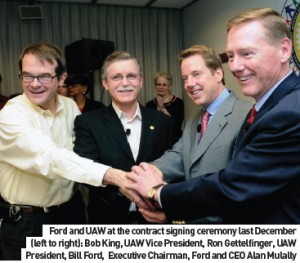 Planning and programming
Planning and programming
“I use the word ‘sophisticated’ because it means we are finding ways to more fully take advantage of the robot’s capabilities by tying it to other high-tech processes. For example, we’re rethinking the way product development engineering and manufacturing engineering work together through the use of virtual build programmes.
“We took advantage of virtual build as we were planning the Ford Edge and it helped us to anticipate and avoid many problems on the assembly line. We can now simulate onscreen the interaction between robots, human operators, vehicle bodies and components on the line, and look for possible problems in human and machine ergonomics. “This isn’t an improvement in robotics, per se, but it certainly is an improvement in how we plan their work in advance of programming them on the pre-launch line. “This is just the tip of the iceberg in improving the way we humans interact with our robots. With the advent of flexible manufacturing, we’re realising that we need to have closer physical interaction between robots and operators than we’ve had in the past. Specifically, there are times when it would be advantageous to enable an operator to load parts directly onto a robot.”
Paramount safety
Hinrichs understands completely the safety concerns that arise from such interaction, categorically stating that there is no priority in its plants higher than worker safety. To incorporate the new working practice into industry standards, Ford has safety engineers working with the RIA to examine and potentially modify the RIA’s standards regarding human and robot interaction.
“The increased numbers of robots on our plant floor – and the fences that surround them – eat up a substantial amount of our floor space. We’d like to reclaim a bit of that real estate by finding ways to redefine the limits to efficiency and flexibility that are imposed by the current RIA standards. “We know that GM and Chrysler are doing the same thing, and probably for the same reasons. But I’d like to advocate the approach we’re taking at Ford. We’re conducting very careful risk assessment of any proposed changes, in order to assure absolute consistency in any actions we take.
“We’re testing our ideas with the pre-launch work on a future product at our Buffalo stamping plant. We’re looking at the 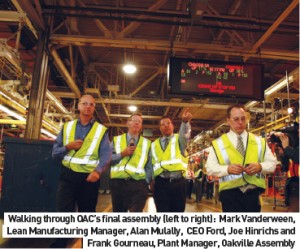 way we load two different sheet metal panels with a quick-change end effector. We’re confident that we can arrive at a solution that will, first and foremost, ensure the safety of our people as we also increase the efficiency of our operations. “It’s equally important to us that we work closely with the UAW in these modifications to work procedures, and I have to say their diligence and cooperation has been tremendous so far. Both management and union recognise how much is at stake as we turn our company around and are willing to work toward that very positive common goal.”
way we load two different sheet metal panels with a quick-change end effector. We’re confident that we can arrive at a solution that will, first and foremost, ensure the safety of our people as we also increase the efficiency of our operations. “It’s equally important to us that we work closely with the UAW in these modifications to work procedures, and I have to say their diligence and cooperation has been tremendous so far. Both management and union recognise how much is at stake as we turn our company around and are willing to work toward that very positive common goal.”
Robot wish list
Something that robot manufacturers were keen to prise from Hinrichs was what improvements or innovations Ford, along with other OEMs, was looking for in future robots. The answer fell into three distinct categories: cost, reliability and service, expanded capabilities and increased sophistication. “Yes, we wish robots weren’t so expensive so we could buy more of them,” he confirms. “We would like them to be more reliable and easier to fix. Maintenance of robots in our paint operations could be better. I know the robot guys are working on all these issues.
“Second, however, is perhaps more elusive. We’d like to see robots with expanded capabilities, and by that I mean robots that are smaller, but stronger and able to carry heavier loads. A big wish is for a multipurpose robot that can weld, seal and handle material. This would be a boon for us because it would enable us to standardise our plants and simplify maintenance. Ideally, that robot would be programmed and operated identically across the job. “Third, we’d like to see some increased sophistication in the robots themselves. We’d like to see infinite motion flexibility, so we can achieve even better fit and finish on vehicle exteriors and parts. This becomes even more important as we close the gap on quality with our competition.
“We’d like more vision systems on robot arms so we can see what’s happening at the end effector. We’d also like some sort of collision detection system on robots, especially as we group more robots more closely together in the work cell.
 It would be nice if they could e-stop automatically if an operator moves into a zone and is at risk. “It would also be advantageous to have robots that can reprogram themselves as tasks change within a cell on a flex manufacturing line. And since manufacturing engineering is spending more time in the virtual world, it would be valuable to have robots that could track the position of hoses and cables on the arm and end effector in our virtual-build programs. We’re finding we can’t foresee potential crimping of hose lines in our virtual build scenarios. “Our wish list really comes down to this: we want, someday, to see robots that plug and play, that don’t require an engineering degree to operate and that have consistent programming processes across manufacturers. We want them to be safe, with collision systems and automatic e-stops. And we want them to be small, strong and more accurate.” Hinrichs explains that Ford is already using robots more than they ever thought they would and if they could have some of the things on their wish list, they would find even more ways to use them.
It would be nice if they could e-stop automatically if an operator moves into a zone and is at risk. “It would also be advantageous to have robots that can reprogram themselves as tasks change within a cell on a flex manufacturing line. And since manufacturing engineering is spending more time in the virtual world, it would be valuable to have robots that could track the position of hoses and cables on the arm and end effector in our virtual-build programs. We’re finding we can’t foresee potential crimping of hose lines in our virtual build scenarios. “Our wish list really comes down to this: we want, someday, to see robots that plug and play, that don’t require an engineering degree to operate and that have consistent programming processes across manufacturers. We want them to be safe, with collision systems and automatic e-stops. And we want them to be small, strong and more accurate.” Hinrichs explains that Ford is already using robots more than they ever thought they would and if they could have some of the things on their wish list, they would find even more ways to use them.
Currently, robots are in the ‘washing machines’ that de-burr the engine and transmission components under high pressure, acting as helium ‘sniffers’ that detect engine leaks on the line. Additionally they are used as three-dimensional ‘eyes’ for vision-guided parts handling. These are just some of the innovative examples of innovative robot applications at Ford. But Hinrichs says the carmaker needs even more innovation if it is to keep pace with the changing market. “We need robots that emulate our most important asset, our people. We need robots that are smart, that work hard, that are reliable and that are suited to many tasks. “Robots will never replace people. But they can take the monotony and physical load off our employees and free their arms and their brains for more important tasks.





































